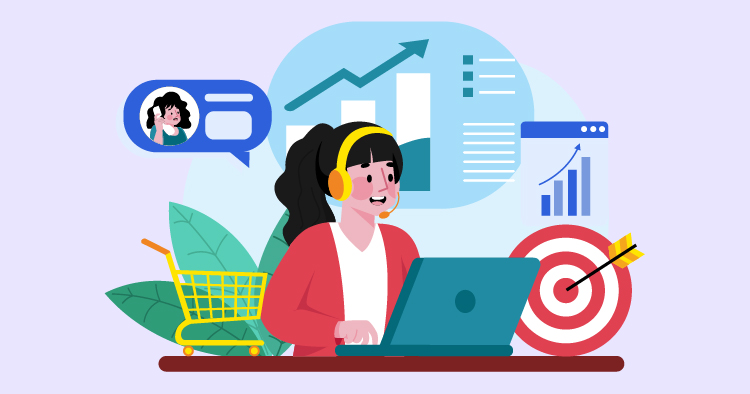The sales conversion funnel is a vital concept in marketing and sales. It represents potential customers’ journey, from first becoming aware of your product or service to purchasing. Understanding and optimizing this funnel is crucial for businesses looking to increase conversion rates and drive revenue growth. By dissecting each stage of the funnel, companies can identify areas for improvement and implement targeted strategies to guide prospects toward a sale. In this guide, we’ll explore the intricacies of the sales conversion funnel and provide actionable insights to help you convert leads into loyal customers.
Understanding the Sales Conversion Funnel
The sales conversion funnel is a concept that helps businesses understand how a potential customer becomes a buyer. It’s like a path that guides people from learning about a product to purchasing. This funnel is crucial for businesses because it shows them how to interact with customers at each stage to increase the chances of making a sale.
The sales conversion funnel has four main stages: awareness, interest, decision, and action. In the first stage, awareness, people discover your product. Next, in the interest stage, they consider whether they need your product. The decision stage is when they think about whether to buy it, and the action stage is when they purchase.
Each stage is essential for its reasons. Awareness is about getting your product known; without it, no one can buy. Interest is about keeping potential customers engaged. The decision stage is crucial because this is when customers choose whether or not to buy. Finally, the action stage is the end goal, where interest becomes a purchase. Understanding and managing these stages well is essential for a successful sales strategy.
The Importance of Awareness in the Sales Conversion Funnel
Awareness is the starting point of the sales conversion funnel. It’s where you begin to introduce your brand to potential customers. When people are familiar with your brand, they’re more likely to think of you when they’re ready to buy. This stage is all about getting noticed and making a memorable impact.
You might use social media, SEO, or content marketing to get your brand seen. These tactics can help you reach more people and interest them in your offer. The key is not just to reach many people but to reach the right people. That means understanding who will likely buy your product and targeting your marketing to them. By focusing on the right audience, you can use your marketing resources more effectively and increase your chances of moving people further down the funnel to make a purchase.
Generating Interest and Building Trust
After getting your audience’s attention, the next step is to keep them interested. This is when you start to spark their curiosity and get them excited about your offering. You want to turn their initial awareness into a keen interest in your products or services.
Using content marketing is a great way to generate this interest. By sharing valuable and relevant content, you can grab your audience’s attention and keep them engaged with your brand. This could include writing informative blog posts, creating engaging videos, hosting webinars, or designing infographics that offer helpful information about your selling.
Struggling with Digital marketing? Book Your Free Strategy Session!
- 30-Minutes Session
- Expert Insights
- Data-Driven approach
- Optimized Strategies for Your Goals
It would be best to build trust and credibility to turn that interest into sales. You can do this by showing off customer testimonials and case studies or delivering outstanding customer service. Being open and consistent when you communicate with your audience also goes a long way in earning their trust.
Nurturing Prospects through the Decision Stage
When prospects reach the decision stage, they’re on the edge of purchasing. They’re considering their options and deciding if your product or service suits them. This stage is crucial because it’s when potential customers think things over.
To help prospects through the decision stage, you must provide them with all the necessary information. This means giving detailed descriptions of your products, transparent pricing, and answers to any questions they might have. Addressing concerns or objections now can make a big difference in whether they choose to buy from you.
Keeping in touch with prospects and reassuring them is critical at this stage. You might use email marketing, personalized messages, or even special deals to engage them. The aim is to support them and give them all the information they need to feel confident about their purchase.
Converting Prospects into Customers
When you reach the action stage, it’s time to see the results of your efforts. This is when prospects decide to purchase, completing their journey through the sales funnel. To get here, you’ve guided them step by step to this point.
To encourage prospects to take that final step, you need strong call-to-actions (CTAs). Your CTAs should be direct and enticing, clarifying what you want prospects to do next. They could be phrases like “Buy Now,” “Sign Up Today,” or “Get Started.” Make sure your CTA grabs attention and prompts that all-important click.
It’s also essential to ensure your landing pages and checkout process help, not hinder, this final action. Your landing pages should be clear and engaging, matching the message of your CTAs. The checkout process should be easy, fast, and secure. If it’s too complicated, people might give up before purchasing.
Tracking and Analyzing Conversion Rates
Understanding how well your sales funnel works means monitoring your conversion rates. This tells you how many of your prospects are moving through each stage of the funnel and how many are buying. Knowing this helps you see if your marketing is working as it should.
Tools like Google Analytics, CRM software, and marketing automation platforms can help you track and understand conversions. These tools help you see what customers do, how many are buying, and other important information. By using these tools well, you can gain insights that help you improve your sales funnel even more.
Struggling with Digital marketing? Book Your Free Strategy Session!
- 30-Minutes Session
- Expert Insights
- Data-Driven approach
- Optimized Strategies for Your Goals
Collecting data is not enough; you must use it. Look for patterns or trends in the numbers that point out areas for improvement. If you see people losing interest at a certain point, you can figure out why and try to fix it. This could mean tweaking your approach to keep people engaged and moving towards a purchase.
Optimizing the Sales Conversion Funnel for Small Businesses
Small businesses often have to work with what they have, which can make refining their sales conversion funnel a bit tricky. However, this can also be a chance to get creative and connect personally with customers. Small companies can craft a funnel that turns browsers into buyers by getting to know their audience and focusing on what makes their business unique.
Key tactics include zoning in on a specific market, using customer testimonials to build trust, and ensuring every customer feels valued. This approach helps a small business stand out and fosters loyalty. How other small businesses have succeeded in this area can offer a treasure trove of ideas and insights. Learning from others‘ success stories is a smart move, whether a brick-and-mortar shop or an e-commerce site.
Leveraging Social Media for Sales Funnel Conversions
Social media is a game-changer in guiding potential customers through the buying process. It’s where people first get to know your brand and start to take an interest. With so many people scrolling through their feeds daily, these platforms are perfect for catching their eye and nudging them closer to a purchase.
Each social media site attracts a different crowd and serves another purpose. For example, LinkedIn is the go-to for business-related networking, while Instagram and Facebook are where you want to be for direct customer engagement. It’s all about picking the right place to share your content and tailoring it to resonate with those who hang out there.
There’s no shortage of small businesses that have harnessed social media to boost their sales. From fashion stores that turn their Instagram likes into sales to local businesses that fill their appointment books with Facebook ads, these stories prove social media can be a potent tool in your sales arsenal with the right strategy.
Email Marketing for Sales Funnel Optimization
Email marketing is a vital strategy for guiding potential customers through buying. It lets you directly communicate with your audience, giving them the information they need to move from interest to purchase. When you send out engaging and relevant emails, you keep your brand in the minds of your consumers, which can lead to higher sales.
To create emails people want to read, start with an attention-grabbing subject line. Then, fill your email with valuable content. You should include a clear call to action so that recipients know what to do next. Personalizing your emails by using the recipient’s name and tailoring the content to their interests can make a big difference in how they respond.
It’s also intelligent to organize your email list into different groups. You can send specific messages appropriate for each sales funnel stage. For example, you might send educational content to those just learning about your products and more detailed information to those considering a purchase. By sending targeted emails, you can help lead your potential customers to a decision.
The Power of Content Marketing in Driving Sales Funnel Conversions
Content marketing creates and shares valuable and exciting information with your target audience. When you provide content that solves problems or answers questions for your potential customers, you establish yourself as a trustworthy expert. This trust is essential for moving people through the sales funnel, from first hearing about you to deciding to buy from you.
To create content that truly resonates with your audience, you must understand what they seek. Whether blog posts, videos, infographics, or eBooks, the content should be well-crafted and address the issues that matter to your audience. Consistently releasing high-quality content at the right time helps keep your audience interested and engaged.
After you’ve created great content, it’s essential to get it in front of as many eyes as possible. Share your content on social media, include it in your email newsletters, and make sure it’s easy to find through search engines. Also, interacting with your audience by responding to comments and joining discussions can increase the effectiveness of your content marketing and help draw more people into your sales funnel.
How SEO Boosts Your Sales Funnel
Search Engine Optimization, or SEO, is a powerful tool for driving people to your website looking for what you offer. When you make your content more appealing to search engines, your site will probably appear in the top search results, which means more visitors who are interested in your products or services.
To make your site SEO-friendly, focus on keywords relevant to your audience, create meta tags and descriptions explaining what your page is about, and ensure your site is easy to navigate. Content is king in SEO, so make sure what you’re putting out there is full of the right keywords and helpful and exciting for the people reading it.
To nail SEO, you must know what your potential customers are typing into search engines. Use these keywords throughout your site naturally and engagingly. It’s all about balancing using the right keywords and writing content that speaks to your visitors.
Boosting Small Business Sales with CRO
Conversion Rate Optimization, or CRO, is all about making your website the best way to get visitors to take action, whether buying something or signing up for your newsletter. For small businesses, CRO is an intelligent way to get more out of the traffic you already have and improve your sales funnel.
To start with CRO, try simplifying how people get around your site, make sure it looks good on mobile devices, and use clear calls-to-action that tell visitors exactly what to do. Your site should also load quickly and have forms that are easy to fill out. Listening to what your users say can help you improve your site.
A/B testing is a big part of CRO. It lets you test out different versions of a webpage to see which one gets the best results. You could try out other headlines, button colors, or layouts. Regular testing and tweaking based on your learning ensures your website is always ready to turn visitors into customers.
Remarketing: Reaching Out to Lost Opportunities
Remarketing is like a second chance to make an impression on someone who visited your website but left without buying anything. Think of it as a gentle nudge to remind them about their interests. This can often turn someone who was browsing into a paying customer.
To make remarketing work, you need to know your audience well. This means dividing them into groups based on what they did on your website. For example, maybe they looked at shoes but didn’t buy or put something in their cart but didn’t complete the purchase. For each group, you create ads that speak directly to their interests. When your messages hit the right note, you’ll likely see those visitors return and buy.
Small businesses have seen genuine success with this tactic. You can learn how suitable ads attract people by looking at their success stories. These stories contain tips and tricks that can help you refine your remarketing efforts.
Customer Retention and Upselling Strategies
Keeping customers coming back is essential for a healthy bottom line. It’s usually cheaper to keep an existing customer than to find a new one. Plus, happy customers tend to buy more over time and can even bring in new customers through word-of-mouth.
To keep your customers loyal, ensure they have a great experience every time. This could mean going above and beyond with customer service, starting a program that rewards them for returning, or ensuring their experience feels personal. Staying in touch through emails or special deals helps keep your brand in their minds. Customers who think they matter to you are likelier to stick around.
Then there’s upselling and cross-selling, which is about making more from each sale. Upselling is when you encourage customers to buy a more expensive version of what they’re already looking at. Cross-selling is when you suggest products that complement their buying. The key is to make these suggestions feel helpful, based on what you know about what they like and what they’ve bought before. When done right, these strategies can increase your sales without being pushy.
Final Thoughts
Successfully navigating the sales conversion funnel is essential for any business aiming to thrive in a competitive market. By meticulously analyzing each stage, from awareness to action, companies can tailor their marketing efforts to meet the needs of their audience better. Reviewing and refining your funnel strategy will ensure that your sales process remains adequate and efficient. Remember, a well-constructed sales conversion funnel increases immediate sales and builds the foundation for sustained business growth through repeat customers and referrals.



